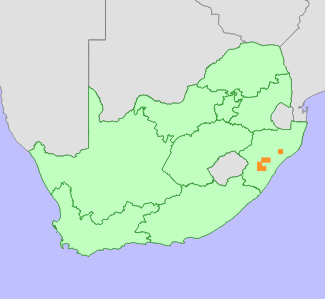|
Scientific Name | Asclepias woodii (Schltr.) Schltr. |
Higher Classification | Dicotyledons |
Family | APOCYNACEAE |
Synonyms | Gomphocarpus woodii Schltr. |
National Status |
Status and Criteria | Vulnerable B1ab(i,ii,iii,iv,v)+2ab(i,ii,iii,iv,v) |
Assessment Date | 2018/07/30 |
Assessor(s) | L. von Staden |
Justification | Asclepias woodii has an extent of occurrence (EOO) of 1000-3662 km², and an estimated area of occupancy (AOO) of less than 1 000 km². Between four and 10 known remaining locations continue to decline due to ongoing habitat loss and degradation, and therefore it is listed as Vulnerable under criterion B. |
Distribution |
Endemism | South African endemic |
Provincial distribution | KwaZulu-Natal |
Range | This species is endemic to KwaZulu-Natal, South Africa, where it is found from the Midlands to Zululand. |
Habitat and Ecology |
Major system | Terrestrial |
Major habitats | Midlands Mistbelt Grassland, Mooi River Highland Grassland, Southern KwaZulu-Natal Moist Grassland |
Description | It occurs in unburnt areas in moist and mistbelt grasslands, 600-1400 m. |
Threats |
| Mistbelt grasslands, particularly in the KwaZulu-Natal Midlands, has been extensively modified due to agricultural and urban expansion, as well as exotic timber plantations, and less than 30% remains intact. Currently, there is ongoing habitat loss and degradation due to low cost housing (Nicholas 1999, Nicholas pers. comm.), alien invasive plants and too frequent fires - this species is adapted to flower in mature unburnt grasslands. |
Population |
Asclepias woodii is known historically from about 13 locations, but recent field surveys have recorded it at only four locations. This species has suffered extensive habitat loss across the KwaZulu-Natal Midlands, but over a period longer than three generations. A continuing decline is inferred from ongoing habitat loss and degradation.
|
Population trend | Decreasing |
Assessment History |
Taxon assessed |
Status and Criteria |
Citation/Red List version | | Asclepias woodii (Schltr.) Schltr. | VU B1ab(i,ii,iii,iv,v)+2ab(i,ii,iii,iv,v) | 2020.1 | | Asclepias woodii (Schltr.) Schltr. | NT B1ab(ii,iii) | 2015.1 | | Asclepias woodii (Schltr.) Schltr. | VU B1ab(ii,iii)+2ab(ii,iii) | Raimondo et al. (2009) | | Asclepias woodii (Schltr.) Schltr. | EN B1B2c | Scott-Shaw (1999) | | Asclepias woodii (Schltr.) Schltr. | Endangered | Hilton-Taylor (1996) | |
Bibliography |
Brown, N.E. 1909. Asclepiadeae. In: W.T. Thiselton-Dyer (ed). Flora Capensis IV Section I (Vacciniaceae to Gentianeae):518-1036. Lovell Reeve & Co., Ltd., London.
Hilton-Taylor, C. 1996. Red data list of southern African plants. Strelitzia 4. South African National Botanical Institute, Pretoria.
Nicholas, A. 1999. A taxonomic reassessment of the subtribe Asclepiadinae (Asclepiaceae) in Southern Africa. Unpublished Ph.D., University of Durban-Westville, Durban.
Raimondo, D., von Staden, L., Foden, W., Victor, J.E., Helme, N.A., Turner, R.C., Kamundi, D.A. and Manyama, P.A. 2009. Red List of South African Plants. Strelitzia 25. South African National Biodiversity Institute, Pretoria.
Scott-Shaw, C.R. 1999. Rare and threatened plants of KwaZulu-Natal and neighbouring regions. KwaZulu-Natal Nature Conservation Service, Pietermaritzburg.
|
Citation |
| von Staden, L. 2018. Asclepias woodii (Schltr.) Schltr. National Assessment: Red List of South African Plants version 2024.1. Accessed on 2025/11/12 |
 Comment on this assessment
Comment on this assessment


